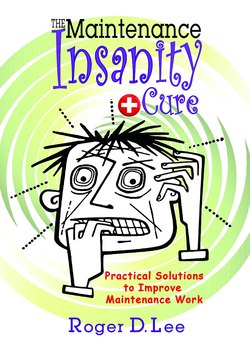Читать книгу The ''Maintenance Insanity'' Cure: Practical Solutions to Improve Maintenance Work - Roger D. Lee - Страница 7
На сайте Литреса книга снята с продажи.
ОглавлениеForeword
I started my efforts on maintenance improvement when work orders were hand written on a three-part carbonless form. They were kept in folders in a desk drawer and the only time there was a list made was for a shutdown. We only needed one folder because nobody created them unless they wanted us to work on them that day. In fact,we didn’t need a folder at all because Mack would just pile them on his desk and when the pile got too high, he would pull the waste basket up beside the desk and rake them into it. The mechanics were oilfield hands who thought the solution to a problem was a bigger hammer or a cheaper pipe. I was the start of an experiment to see if having an engineer in maintenance would help.
I started my journey in reliability and added planning and scheduling when I was put in a supervisory role. I went off to a week-long school taught by the “Master.” The main thing that stuck with me is that he would not sign on to help a company if the president was not willing to approve any emergency job that would disrupt the scheduled work. Roger’s book will make it clear how important this discipline is. My company was a large chemical company and they spent freely on development of employees. We learned directly from Deming and Aubrey Daniels as well as other innovators.
We added engineers in maintenance and created a central reliability group. This was when I became acquainted with Roger Lee. He led this group and I saw it as an asset where other managers saw it as interference. Needless to say I got the best and most help from this group and Roger and I, along with many others developed a maintenance program that had such a noticeable impact at our plant site that the company adopted and spread our processes through the company’s other plant sites. Our company eventually established a new business of marketing our maintenance strategies to other companies for a fee based on verifiable savings. Roger moved to the central offices and led this effort.
Roger was a sincere and dedicated student and innovator in our journey. I appreciate the fact that he has documented our efforts and learnings to help others create a better way of handling maintenance. He knows what he is talking about because he has been there and done it. He is not just writing about what he saw or heard about. This was not an easy journey. The people who operated the plant had to cooperate and do some things that were not comfortable for them and did not make sense from their point of view. They had to share some control and we had some tough characters (who acted more like kings in charge of their kingdom). No one likes change. And with changes like those things can get worse before they get better. The real challenge is for the change agent to stay the course when almost everyone is saying that things aren’t working. But when it does start working and the improvements in time and reduced costs are so evident, even the kings want to know how you are doing it.
One of the greatest myths in maintenance is that improved reliability increases maintenance costs. On the contrary—done properly, as the strategies in this book teach, reliability and significant cost reduction always go hand in hand.
I encourage you to find and use the strategies in this book that will best fit your needs. It took us about 20 years to develop and implement these strategies and I would say that no organization effectively uses all of them. This isn’t a step-by-step approach to improving your efforts, but rather a smorgasbord of opportunities for improvement that can be implemented one at a time based on your needs.
Richard Rossow
September, 2017
